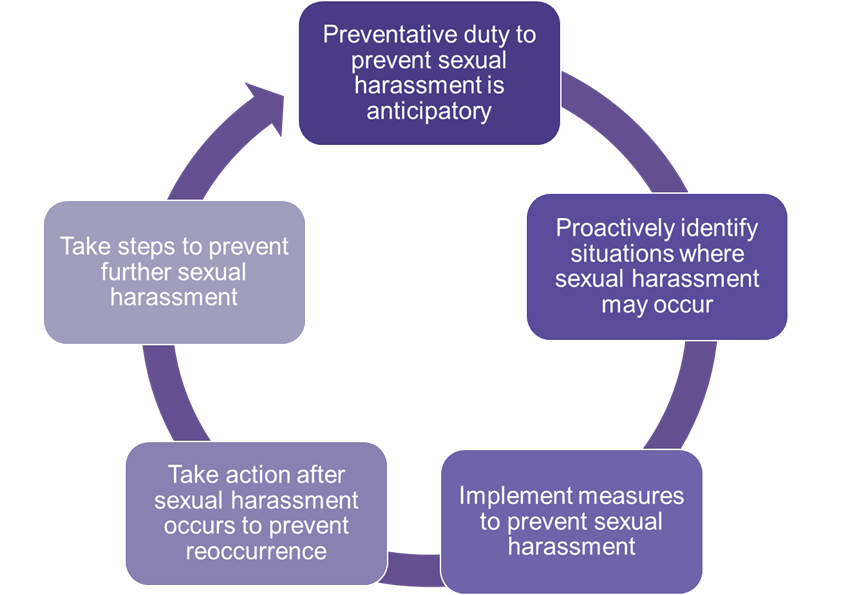New duty to prevent sexual harassment in the workplace
From 26 October 2024 all employers will be required to proactively prevent sexual harassment in the workplace. This briefing note explains what the new rules are and what you need to do now to prepare.
The Worker Protection (Amendment of Equality Act 2010) Act 2023 (the new Act) comes into force on 26 October 2024, and introduces a new duty for employers to take reasonable steps to prevent sexual harassment of employees in the course of their employment.
The Equality and Human Rights Commission (EHRC) has published amendments to its technical guidance on sexual harassment and harassment at work, which contains extra information on the new preventative duty and you can see it here. The guidance contains several case studies and examples which are useful for employers to understand their obligations. The updated guidance introduces a "preventative duty" section, highlighting the need for employers to foresee and prevent potential sexual harassment scenarios.
The duty to prevent sexual harassment: what’s new?
Sexual harassment in the workplace is already prohibited under the Equality Act 2010 (the EqA). If conduct is unwanted conduct of a sexual nature, it does not matter whether that conduct was intended to cause distress or not, as long as the conduct has the effect of violating a person’s dignity or creating an intimidating, hostile, degrading, humiliating or offensive environment. Of course, whether or not it has that effect depends on the victim’s perspective and whether their reaction is reasonable in all of the circumstances.
Employers do not need to have even been aware of the conduct to be held vicariously liable for harassment by their employees if it occurs during employment. However, they have a defence to claims if they can show that they took "all reasonable steps" to prevent the harassment. This is a high bar.
Whilst this existing framework encourages employers to implement preventative measures (training for example), the new Act now imposes a mandatory legal duty on employers to proactively prevent sexual harassment of employees while they are at work by taking reasonable preventative actions.
This new duty sits alongside the existing obligations under the EqA but does not establish an independent cause of action for employees to pursue in an employment tribunal. Instead, allegations of a breach of this duty can only be considered by a tribunal where an employee’s claim for sexual harassment has been upheld.
Should an employee win a sexual harassment claim at an employment tribunal and the employer is found to have neglected their duty to take reasonable preventative steps, the tribunal may increase the compensation awarded by up to 25%. Given that there is no upper limit on the compensation for discriminatory harassment, this increase could be substantial.
Additionally, the new Act gives the EHRC the power to enforce the new duty and it will be taking a keen interest. The EHRC’s powers to enforce the new duty to prevent sexual harassment include the power to:
- investigate potential breaches;
- serve notices requiring employers to prepare an action plan to remedy breaches and prevent future breaches;
- require employers to enter into legally binding agreements to take certain steps to address issues of discrimination or harassment; and even
- seek injunctions against an employer to restrain it from committing an unlawful act.
Harassment by third parties is not currently covered by the law (although the new Government has just put forward an amendment (i) requiring employers to take all reasonable steps to prevent sexual harassment and (ii) to include third party harassment in the provisions of the EqA in its recently published and much awaited Employment Rights Bill). So, whilst a failure to comply with the duty in relation to third parties is unlikely to lead to an uplift to compensation in most cases at the moment because this only applies where the employer is found liable for the sexual harassment, this is set to change.
The EHRC’s powers of enforcement will still apply, however, which means a failure of this duty in relation to third parties, such as customers, clients or visitors, could already lead to difficult EHRC investigations and reputational damage and the EHRC's updated examples highlight the expectation that employers will take third party harassment as seriously as internal incidents. Accordingly, employers should already be taking third party harassment as seriously as any other form of sexual harassment in the workplace.
The EHRC has limited resources but the introduction of the new Act will bring with it more public awareness, which in turn may prompt more direct complaints to the EHRC, thereby inviting media scrutiny and reputational issues for companies which fail to prevent sexual harassment.
What should employers be doing now?

As the EHRC notes, the preventative duty is an anticipatory duty and employers should act now before any incidents of sexual harassment occur. Employers should proactively identify situations when its workers may be subject to sexual harassment in the course of employment and implement measures to prevent harassment taking place. If sexual harassment has taken place, the preventative duty means an employer should take action to stop sexual harassment from happening again.
Reasonable preventative steps will vary depending on factors including the employer's size, sector, and resources, with larger employers expected to do more.
The EHRC published an ‘Employer 8-step guide: Preventing sexual harassment at work’ on 26 September 2024 which can be found here. It recommends employers take the following steps:
Develop an effective anti-sexual harassment policy
Employers should review their contracts, policies and procedures to ensure that they take account of the new duty and bring any changes to the attention of the workforce. Developing a comprehensive and widely communicated anti-harassment policy which includes third party harassment will be an important step to take. The policy should specify who is protected, state that sexual harassment will not be tolerated and is unlawful and that harassment may lead to disciplinary action up to and including dismissal. The policy should also provide clear examples of sexual harassment which are relevant to the working environment.
Engage your staff
Employers must make their workers aware of how they can report sexual harassment and the consequences of breaching the policy. Employers may be able to explore ways to, not only hear their employees’ concerns, but to utilise their knowledge and ideas. Whether via more formal surveys, staff liaison groups or committees or through informal group discussions in person or on message boards, employers may find that their employees are willing to share their own experiences and ways in which they think the organisation could better protect its staff. Consider also structured knowledge sharing, such as reverse-mentoring schemes involving senior managers as another way to utilise employee knowledge and demonstrate commitment to fostering an inclusive and diverse workplace.
Carry out a risk assessment
Employers should identify and mitigate risks in their specific workplaces to their employees. Any such assessment could involve the use of employee surveys, looking at complaint records, exit interviews and any culture audits. Employers should consider the risk from all sources, including third parties such as customers, clients and visitors. They should also consider where any power imbalances lie, whether staff socialise outside of work and whether there is any disrespectful behaviour taking place at work.
Reporting
Employers should provide clear and accessible channels for employees to voice harassment concerns, for example, dedicated internal hotlines to make it easier for employees to notify of any issues arising. All reports must be regarded seriously and investigated swiftly and impartially. Employers should audit or monitor complaints regularly in order to spot any increasing trends and then tailor training (outlined above) to the issues arising in practice to stop problems escalating at an early stage. The results of investigations should be conveyed to the relevant parties, and any broader systemic issues uncovered in the process must be tackled. Consider designating skilled individuals to take responsibility for overseeing any relevant follow up action.
Training
Employers should implement regular training sessions across their organisation. There is no one-size-fits all approach to training; employers should make the training as relevant as possible to make the most impact, for example by using examples applicable to their own workplace. Training should be tailored to different groups within the organisation and should be ongoing, especially in businesses with high staff turnover. Employers should keep records of who has received training and really make sure that senior management is setting the tone by being seen to be actively setting and supporting the agenda through active participation and demonstrating a zero-tolerance approach to harassment.
What to do when a harassment complaint is made
Employers should act immediately to resolve the complaint, respect the confidentiality of all parties, and take account of how the worker wants it to be resolved. Steps such as moving the alleged harasser to a different team from the complainant may be necessary to protect the complainant during the investigation. If the harassment complained of may be a criminal offence, employers should speak to the individual about whether they want to report it and support them with this if they do. Always ensure the complaint outcome and any appeals are reported in a timely manner.
Dealing with harassment by third parties
Employers should take steps to prevent harassment from a third party such as a customer, client, visitor or supplier. Putting reporting mechanisms in place or assessing high-risk workplaces are key steps in protecting employees here.
Monitor and evaluate actions
Finally, it will be important for organisations to monitor and review the steps taken, progress made and any changes to the culture of the organisation. Update risk assessments, training and above all, keep records of everything so that they can show, to an employment tribunal if necessary, that the organisation has indeed taken reasonable steps to prevent sexual harassment of employees in the course of their employment.
Employers should really make clear their intent in this area. They should consider updating their websites, blogs and internal communications as well as installing clear signage and notices on premises both for employees and visitors, customers and clients to support the culture that no harassment of staff is acceptable. Remind staff ahead of any specific work events or celebrations (particularly if alcohol is to be served) of the organisation’s expectations for behaviour and encourage staff to report concerns.
Laying the Groundwork
Whilst it is clearly difficult for employers to enforce the behaviour of their own employees, let alone third party customers, clients and visitors, it is increasingly important for employers to take preventative action and make abundantly clear to employees and third parties that they will not tolerate sexual harassment of their employees. Preventing sexual harassment will not only help employers to adhere to the duty set out in the new Act and prepare them for the future requirement to take all reasonable steps which will be introduced as a result of the new Employment Rights Bill, but this also aligns with broader diversity, equity and inclusion initiatives, contributing to a healthier workplace culture, potentially reducing complaints, absences and turnover. Given the Government’s commitment to going further to protect employees against all forms of workplace harassment in the future, these changes should be regarded as a sign of things to come.
















